5th Earth-directed CME produced as long duration M7.9 solar flare erupts from Region 2371
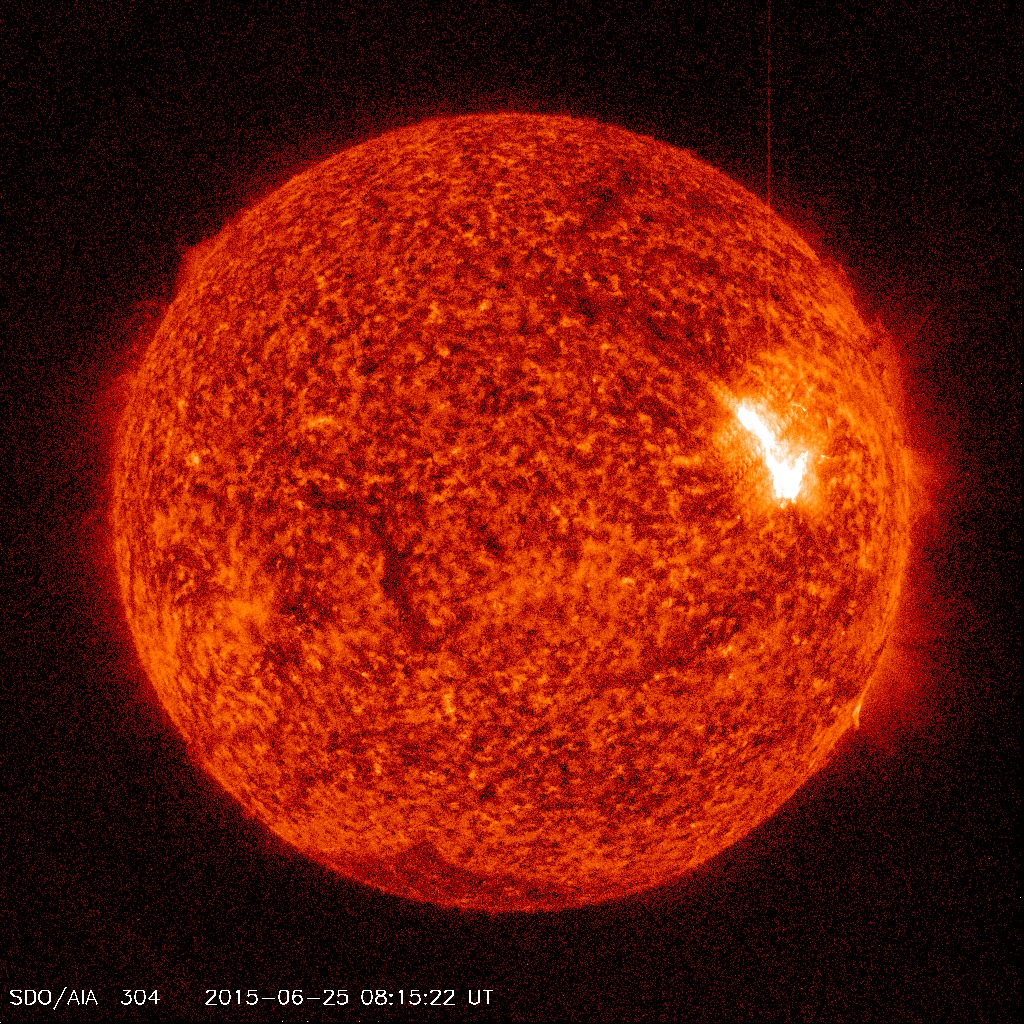
Region 2371, the source of 4 Earth-directed Coronal Mass Ejections (CMEs) over the past couple of days, erupted with long duration M7.9 solar flare (R2-Moderate) at 08:16 UTC on June 25, 2015. The event started at 08:02 and ended at 09:05 UTC.
A Type II (estimated velocity of 2 056 km/s) and IV radio emissions were associated with the event indicating a CME was produced.
Additionally, a 10cm Radio Burst lasting 51 minutes (peak flux 3800 sfu) was registered starting at 08:12 UTC. A 10cm radio burst indicates that the electromagnetic burst associated with a solar flare at the 10cm wavelength was double or greater than the initial 10cm radio background. This can be indicative of significant radio noise in association with a solar flare. This noise is generally short-lived but can cause interference for sensitive receivers including radar, GPS, and satellite communications.
The flare had an associated CME that first breached LASCO's C2 occulting disk at 08:36 UTC. The asymmetric full halo signature strongly suggests this is an Earth-directed event. Modeling of the CME is currently in progress,SWPC said at 12:30 UTC.
Region 2371 has rotated away from the center of the disk, but still poses a threat for Earth-directed CMEs.
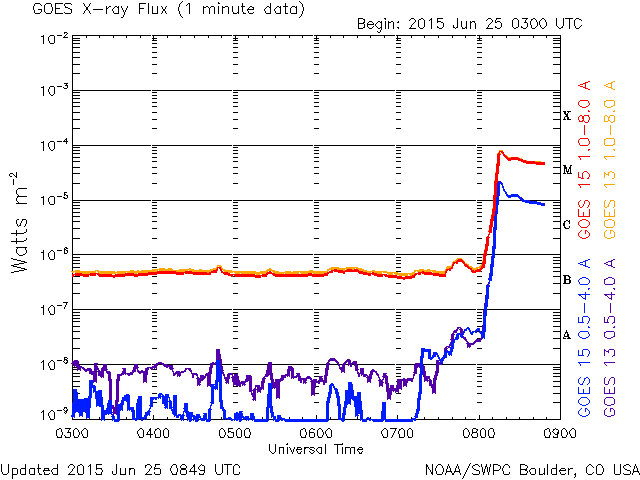
Space Weather Message Code: ALTTP4
Serial Number: 509
Issue Time: 2015 Jun 25 0854 UTC
ALERT: Type IV Radio Emission
Begin Time: 2015 Jun 25 0821 UTC
NOAA Space Weather Scale descriptions can be found at
www.swpc.noaa.gov/NOAAscales
Description: Type IV emissions occur in association with major eruptions on the sun and are typically associated with strong coronal mass ejections and solar radiation storms.
***
Space Weather Message Code: ALTTP2
Serial Number: 1018
Issue Time: 2015 Jun 25 0850 UTC
ALERT: Type II Radio Emission
Begin Time: 2015 Jun 25 0816 UTC
Estimated Velocity: 2056 km/s
NOAA Space Weather Scale descriptions can be found at
www.swpc.noaa.gov/NOAAscales
Description: Type II emissions occur in association with eruptions on the sun and typically indicate a coronal mass ejection is associated with a flare event.
***
Space Weather Message Code: SUM10R
Serial Number: 667
Issue Time: 2015 Jun 25 0917 UTC
SUMMARY: 10cm Radio Burst
Begin Time: 2015 Jun 25 0812 UTC
Maximum Time: 2015 Jun 25 0815 UTC
End Time: 2015 Jun 25 0903 UTC
Duration: 51 minutes
Peak Flux: 3800 sfu
Latest Penticton Noon Flux: 110 sfu
NOAA Space Weather Scale descriptions can be found at
www.swpc.noaa.gov/NOAAscales
Description: A 10cm radio burst indicates that the electromagnetic burst associated with a solar flare at the 10cm wavelength was double or greater than the initial 10cm radio background. This can be indicative of significant radio noise in association with a solar flare. This noise is generally short-lived but can cause interference for sensitive receivers including radar, GPS, and satellite communications.
***
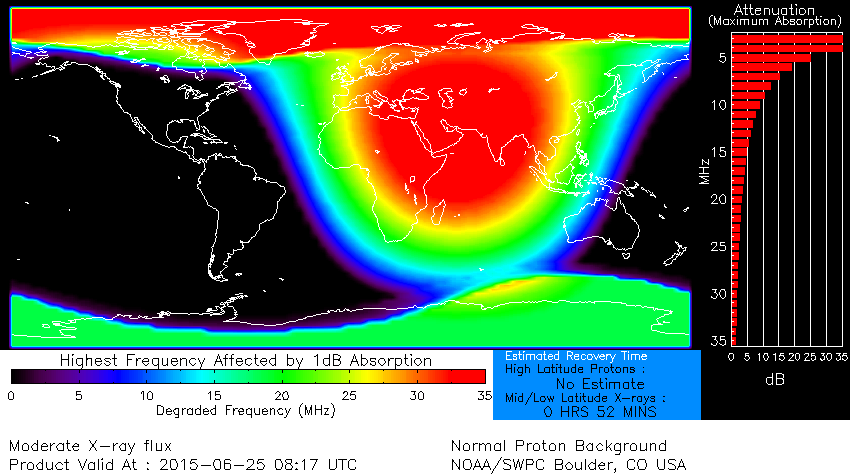
Space Weather Message Code: ALTXMF
Serial Number: 256
Issue Time: 2015 Jun 25 0819 UTC
ALERT: X-Ray Flux exceeded M5
Threshold Reached: 2015 Jun 25 0815 UTC
NOAA Scale: R2 – Moderate
NOAA Space Weather Scale descriptions can be found at
www.swpc.noaa.gov/NOAAscales
Potential Impacts: Area of impact centered on sub-solar point on the sunlit side of Earth. Extent of blackout of HF (high frequency) radio communication dependent upon current X-ray Flux intensity. For real-time information on affected area and expected duration please see http://www.swpc.noaa.gov/products/d-region-absorption-predictions-d-rap.
***
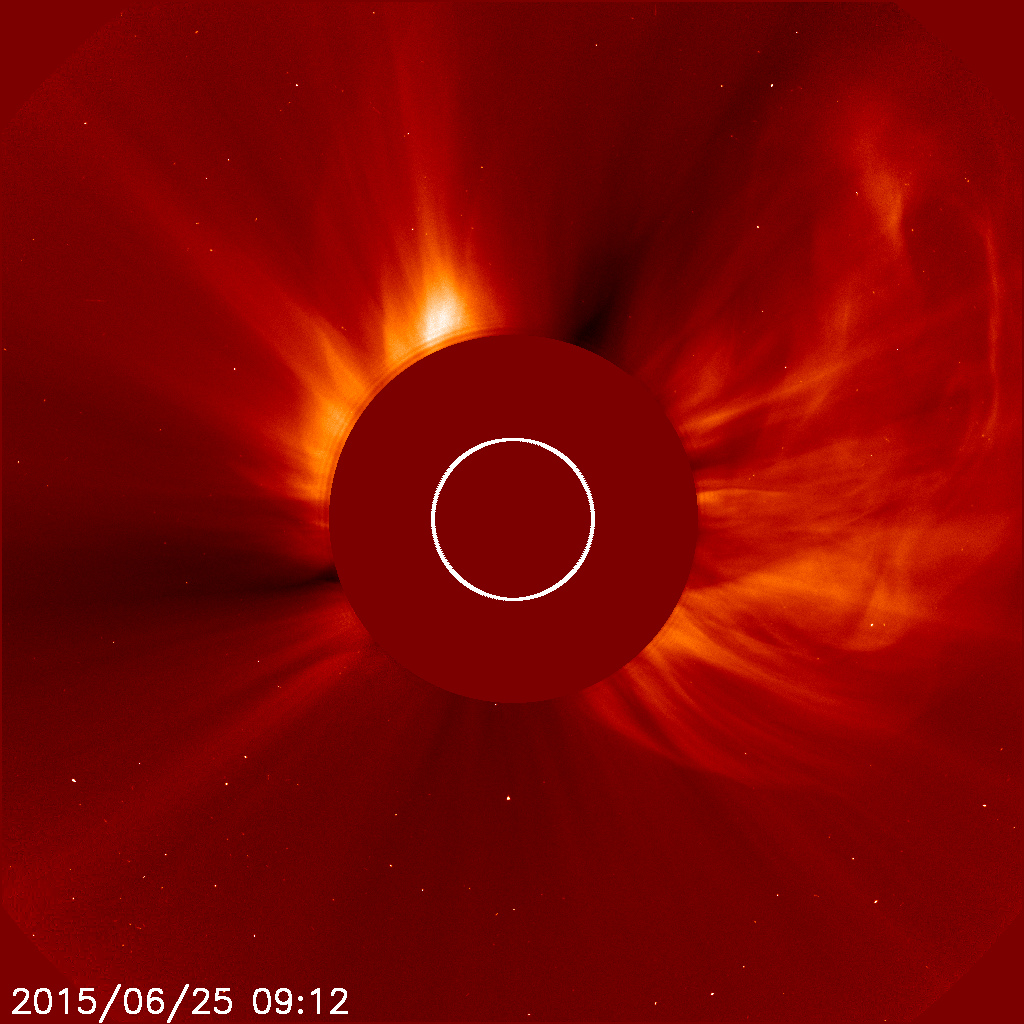
Image credit: ESA/NASA SOHO/LASCO C2.
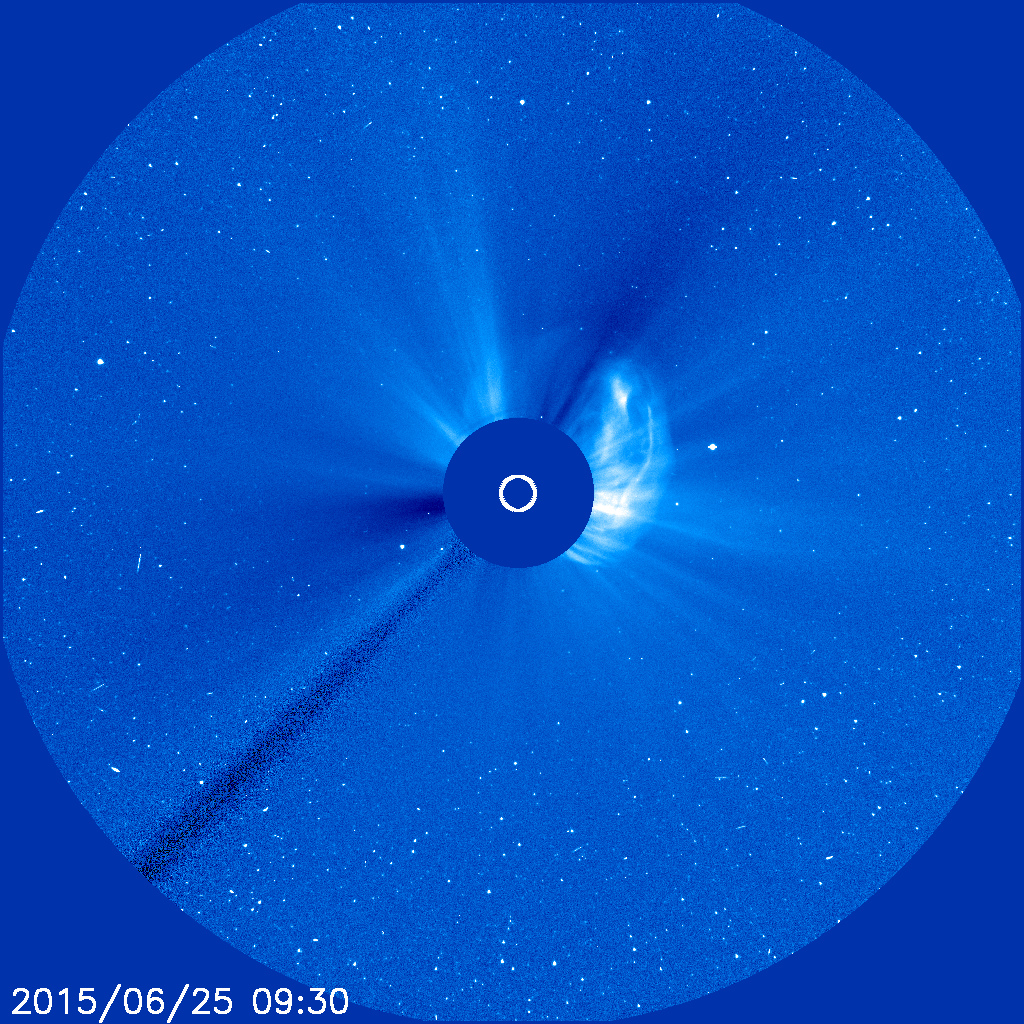
Image credit: ESA/NASA SOHO/LASCO C3.
.jpg)
Sunspots on June 25, 2015. Image credit: NASA SDO/HMI.
At 00:30 UTC on June 25, SWPC said solar activity remains likely to reach moderate levels (R1-R2, Minor-Moderate) over the next three days (June 25 – 27). A slight chance for an isolated X-class (R3-Strong) event persists as Region 2371's size and complexity retain some potential for another significant flare event.
Over the last 24 hours (00:30 on June 24 – 00:30 UTC on June 25), the greater than 2 MeV electron flux increased from low to very high levels, as it reached a peak flux of 26,376 pfu at 16:20 UTC on June 24. The greater than 10 MeV proton flux began the same period at S1 (Minor) levels, trending downward below S1 (Minor) by the end of the period.
The greater than 2 MeV electron flux has the potential to reach very high levels on from June 25 – 27, following elevated solar wind velocities from the two recent CME arrivals. The greater than 10 MeV proton flux dropped below S1 (Minor) levels at 07:05 UTC on June 24 and is expected to lower towards background levels over the next three days, with the exception of a sizable flare/CME from Region 2371, as this region would be in a favorable position to be well connected with Earth for another solar radiation storm at or above S1 (minor).
Solar wind parameters began the period under continued, but waning, transient conditions from the June 21 CME. Total field strength began the period at 12 nT and wind speeds around 600 km/s. Both parameters demonstrated a steady downward trend with total field strength just above 5 nT and wind speeds just above 500 km/s until 13:00 UTC on June 24. At that time, it appears that the anticipated CME from June 22 arrived. Bt increased to 15 nT and solar wind velocities increased to over 700 km/s. Bz however remained largely positive and the overall strength of this event was disappointing versus forecast expectations.
Solar wind parameters are expected to reflect waning CME effects through June 25. Solar wind velocities are expected to continue on a decreasing trend, along with the expectation for a decrease in Bt. A rotation to a period of -Bz is still possible. By June 26, conditions should largely recover to near ambient background conditions, which are expected throughout June 27.
Despite the arrival of the CME from June 22 at 13:00 UTC, the geomagnetic field activity decreased to unsettled and eventually quiet conditions, as a result of a weak Bt and little negative Bz. It is forecast to continue with less than originally expected response to the CME.
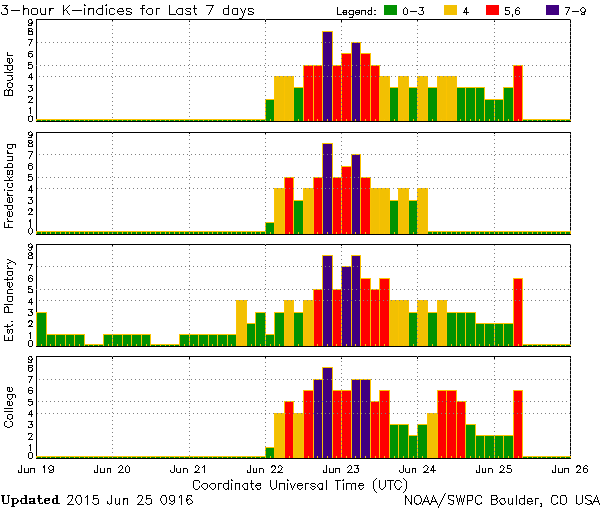
Geomagnetic field further destabilized and G2-Moderate geomagnetic storm (K-index of 6) threshold was reached at 08:13 UTC on June 25. Area of impact primarily poleward of 55 degrees Geomagnetic Latitude.
Under G2 geomagnetic storm conditions power grid fluctuations can occur, high-latitude power systems may experience voltage alarms. Satellite orientation irregularities may occur; increased drag on low Earth-orbit satellites is possible. HF (high frequency) radio propagation can fade at higher latitudes.
Aurora may be seen as low as New York to Wisconsin to Washington state.
More information about today's G2-Moderate geomagnetic storm can be found here.
.gif)
This page will be updated when more data about today's M7.9 flare becomes available.
Featured image: NASA SDO/AIA 304 at 08:15 UTC on June 25, 2015 – M7.9.

Commenting rules and guidelines
We value the thoughts and opinions of our readers and welcome healthy discussions on our website. In order to maintain a respectful and positive community, we ask that all commenters follow these rules:
We reserve the right to remove any comments that violate these rules. By commenting on our website, you agree to abide by these guidelines. Thank you for helping to create a positive and welcoming environment for all.